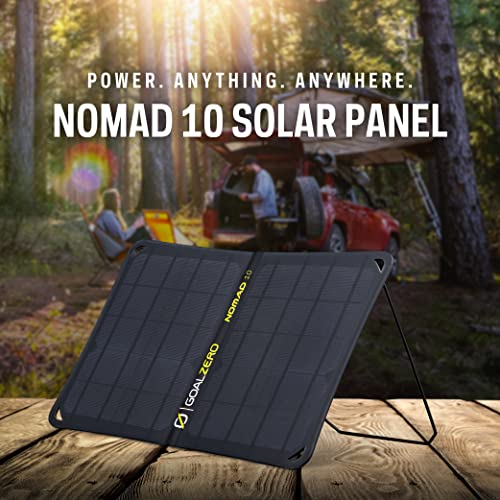From cell phones and GPS to Kindles and power banks, backpackers now carry more power-hungry gadgets than ever. Some gadgets running out of juice may be an inconvenience, whilst with others it could spell disaster. But on longer backpacking or thru-hiking trips, how can you make sure they stay charged?
To ensure your backpacking trips are hassle-free, we’ve identified 8 of the best portable solar chargers, with the BigBlue 3 topping the list. Other excellent models include the Anker PowerPort Solar Lite 15W, BEARTWO Portable, Goal Zero Nomad 10, BioLite SolarPanel 5+, Nekteck 21W, Riapow Solar Power Bank, and the OEUUDD 25000mAh Portable Solar Power Bank.
But what is a solar charger and why should you buy one for your backpacking adventures? We answer these questions and offer buying advice to help you select the best option for you. Key features to consider in a good solar charger are weight and size, wattage, USB ports, and integrated batteries.
Portable Solar Charger: Quick Recommendations
-
Editor’s Choice:
BigBlue 3
“This charger can juice up three devices at once at scarily fast speeds and even works in cloudy conditions.” -
Runner Up:
Anker PowerPort Solar Lite 15W
“Probably the most trail-ready option out there.” -
Best Budget (and Best Ultralight):
BEARTWO Portable Solar Charger
“Weighing in at a piddly 7.4 ounces, this is the lightest option on our list.” -
Best For Fast Charging:
Goal Zero Nomad 10
“Our go-to on weekend trips when we need to juice up our devices fast.” -
Most Portable:
BioLite SolarPanel 5+
“There are smaller devices out there, but not many that come with an integrated battery or pack the Biolite’s power.” -
Honorable Mention:
Nekteck 21W
“A good low-cost alternative to the Anker PowerPort Lite and BigBlue 3.” -
Best For Added Features:
Riapow Solar Power Bank
“A power bank, solar charger, flashlight, and wireless charger in one!” -
Best Value:
OEUUDD Portable Solar Charger Power Bank 25000mAh
“A powerful device that’s portable enough for longer-term backcountry adventures.”
Best Backpacking Solar Panel By Category
Budget: BEARTWO Portable Solar Charger and OEUUDD Portable Solar Charger
Integrated Battery: BioLite SolarPanel 5+ and OEUUDD Portable Solar Charger
Compact: BigBlue 3, BEARTWO Portable Solar Charger, and Goal Zero Nomad 10
What Are The Best Solar Panels For Backpacking?
Our shortlist for the best solar chargers for backpacking is below, with the BigBlue 3 winning the Editor’s Choice title.
- BigBlue 3
- Anker PowerPort Solar Lite 15W
- BEARTWO Portable Solar Charger
- Goal Zero Nomad 10
- BioLite SolarPanel 5+
- Nekteck 21W
- Riapow Solar Power Bank
- OEUUDD Portable Solar Power Bank 25000mAh
BigBlue 3
Editor’s ChoiceThe BigBlue 3 is a powerful solar charger ideal for buyers with multiple power-hungry devices and winner of our editor’s choice award.
This is the most powerful product on our list, with an actual output of 20 watts max. It comes with six IPX4-rated, water-resistant solar panels that fold out. The benefit of having six panels of solar cells is that it makes charging your devices faster. However, it also means that the BB is quite heavy. At 23 oz., this is no lightweight, but the added power makes it well worth it in our eyes.
We were particularly impressed with the high-efficiency rating of the panels, which ranges from 21.5 to 24%. With most panels hovering somewhere between 15 to 20%, the BB3 represents a significant upgrade. In the field, the BB3 also outperformed all of the competition in cloudier conditions.
(Confession: We honestly never knew that a solar panel could charge without direct and strong sunlight before the BB3 proved us wrong!)
When folded, the Big Blue 3 has similar measurements to a magazine at 11.6 x 6.3 x 1.3 inches making it compact enough to fit into most backpacks. The included hooks allow you to attach it to your backpack or anywhere else suitable to catch the sun’s rays. For a hiking solar charger of this size, the 23 oz. weight is reasonable.
It comes with three output ports so you can charge devices at the same time and is compatible with the usual small devices. It also has enough output to charge most DSLR cameras. It comes with a micro-USB cable, but you’ll need to use the original cable if you want to charge Apple devices.
One standout feature of this charger is that it comes with an integrated digital ammeter. Given that it already offers good value without the ammeter, this gives it the edge over many of its competitors. The digital ammeter measures and displays the number of amps, which allows you to find the ideal position to place your panels to get the best results.
To top things off, the BB3 charger uses SmartIC Technology to identify the connected device and deliver the fastest charging speed possible.
However, the Big Blue 3 isn’t entirely flawless. It comes with a zippered pouch that, at first glance, seems like a useful addition for holding your devices. But the sun-facing black pocket will get super-hot, and any device you put inside it is liable to overheat.
PROs
- High-efficiency rating
- Fast charging of up to three devices at once
- Can charge DSLR cameras
- 24-month warranty
- Inbuilt Digital ammeter
- SmartIC Technology
- Performs well in cloudy weather
CONs
- Flawed pouch system
- Quite heavy
Bottom-Line: A slightly heavy but otherwise outstanding charger that packs plenty of features and nigh-on unrivaled power. A great pick for short backpacking trips and one of the best camping solar chargers out there.
Anker PowerPort Solar Lite 15W
Runner UpThe tough, trail-ready Anker 15W was a close runner-up for our top prize, an ideal solar charger for backpackers needing plenty of power without compromising on portability.
This might look similar to other folding portable solar panels for backpacking, but it’s the quality of the product that puts it head and shoulders above much of the competition.
When folded, the Anker PowerPort measures 15W is 11 × 6.3 inches. Weighing in at just 12.5 oz and measuring a super-thin 0.7 inches thick, it’s an excellent choice for backpacking. It also uses industrial-strength PET, plastic-faced solar panels. These are sewn into hard-wearing polyester canvas and have nylon loops on each corner to attach to your backpack.
The Anker PowerPort 15W uses PowerIQ fast charging technology so that you can charge two devices at the same time as quickly as possible. It boasts speeds of up to 2.4 amp per charging port or 3 amps overall if there is adequate direct sunlight.
This charger is compatible with Android smartphones and tablets and most Apple devices, but, sadly, cannot charge Asus tablets, HP TouchPads, the iPod Classic, iPod Nano, or iPod Shuffle.
As long as you don’t want to use the devices mentioned above, this is an excellent pick. If you invest in this charger, you are backed by an industry-leading brand in charging devices and get a reassuring 18-month guarantee.
If you need a little more power and slightly faster-charging speeds, check out the PowerPort 15W’s big brother, the Anker Power PowerPort 21W.
BEARTWO Portable Solar Charger
Best Budget (and Best Ultralight)The BEARTWO comes out on top not only for best budget buy but also for best ultralight. It’s a superbly lightweight and portable solution, that’s a little short on power but comes with a handy built-in battery.
This battery pack can be charged in three different ways: using the included Micro USB to charge from a PC or laptop; using a wall adapter; or by sunlight.
For portability, this device is ideal, it weighs just 7.4 ounces and its dimensions are a tiny 5.51 x 2.95 x 0.7 inches. This means it is compact enough to fit in the palm of your hand. It might be a little bulky for a pocket in your pants, especially if hiking, but it would easily fit into a side pocket of a backpack.
The design is simple and effective. One side is taken up by the solar panel, with a small cut-out corner at the top that lets you attach it to your backpack with a carabiner or cord. At the top, there’s an LED on/off button, and on the top and side, you have dual output ports covered with a rubber cap for water protection.
While this charger automatically detects the charging device to deliver the optimal current, it is a little on the slow side, particularly when charging two devices at once.
It offers 5 watts maximum wattage, and the internal 2000mAh Li-Poly battery will take 8 to 10 hours to fully charge in direct sunlight, or 4-5 hours via USB. It will charge pretty much any small device such as phones, MP3 players, Kindle, GPS units, and Bluetooth headsets.
PROs
- Dual output
- Compact
- Ultralight
- Simple to use
- IP67 waterproof rating
CONs
- Slower charging speed with 2 devices
Bottom-Line: An impressively portable little device that lacks power and versatility but offsets these flaws with its tiny footprint and easy-to-use design. Possibly the best ultralight backpacking solar charger out there.
Goal Zero Nomad 10
Best For Fast ChargingThe Goal Zero Nomad 10 is a powerful, portable, and fast-charging device, perhaps a little too heavy for thru-hikes but ideal for shorter, overnight trips in the backcountry.
Goal Zero is a US-based company that is renowned for its high-quality portable power solutions. They are constantly updating and reengineering their product line to ensure that customers get the best value for their money.
The Goal Zero Nomad 10 is a 10-watt solar charger designed for outdoor adventures. It’s both durable and waterproof. It comprises a fold-up panel and an integrated USB port. It’s a simple design, granted. But while many other folding solar panels often have patchy solar charging abilities, the Goal Zero Nomad 10 is quick and highly efficient.
It can be used to power small devices such as phones, GPS units, fitness trackers, and power banks. The Nomad 10 compactly folds away for comfortable storage in your backpack when not in use. Or you can use carabiners or lanyards to attach it to the exterior of your pack, using the four eyelets on each corner of the panel.
While on the surface, it might look like other similar folding portable solar chargers, there is more to it than initially meets the eye. At the back of the panel is a 180° detachable kickstand that provides additional stability. This also allows it to be propped up and angled so that it can be positioned to where the sun is at its strongest for optimum performance.
Though it has to be just about the best solar panel for backpacking we’ve looked at for efficiency and the quality of its design, the Goal Zero’s not the lightest. At 1.2 lbs it’s one of the heftiest models in our review and, thus, not ideal for buyers who prioritize weight savings.
PROs
- High-quality device
- Adjustable kickstand
- 1-year warranty
- Charges quicker than competitors
CONs
- It doesn’t come with any extras such as cables or carabiners
- A little heavy
Bottom-Line: A practical, fast-charging, and efficient solar charger that loses a few points on account of its ponderous weight.
BioLite SolarPanel 5+
Most PortableThe BioLite SolarPanel 5+ is backpack-friendly and one of the best portable solar chargers around. It charges devices a little more slowly than others but is well-equipped to deal with the rigors of backcountry travel.
BioLite is an innovative outdoor products company that provides ways to charge, cook, and light off-grid. The SolarPanel 5+ comes with an integrated 2200 mAh battery. This gives you the option to power your device directly when the sun is shining or charge the battery pack to store power for later to re-juice your device when you camp up at night.
The SolarPanel 5+ consists of a single rigid 5-watt monocrystalline solar panel that can charge your smartphone in around two hours in peak sun. It has one charge-out port with a 5-watt output and a micro charge-in port so you can top up before leaving home.
This charger is excellent for backpacking as it is ultrathin, weighs just under 14 oz., and is also water-resistant enough to handle light rain. It can power electrical devices such as smartphones but is also compatible with other BioLite products such as their cookstoves and power light.
As well as its minimalist compact design, it has a few other well-thought-out features that make it stand out from some of the other generic portable chargers on the market.
It comes with a useful auto-reconnect feature that will make sure that the charger and your device re-engage when the weather turns from cloudy to sunny. Also, it comes with a 360-degree kickstand allowing you to angle it easily on uneven ground. The final feature of note is the inbuilt sundial that helps align the charger with the sun for maximum output.
The main downside to this charger is that, because of its compact design and 5 watts output, it’s fine for charging smaller devices but might struggle a little with devices with larger batteries.
PROs
- Integrated, high-capacity battery
- Ultralight & ultraslim design
- 360-degree kickstand
- Sundial
- Good backup battery storage capacity
- Durable materials
CONs
- Low power output
Bottom-Line: If you are looking for a robust, lightweight charger with an integrated battery, the BioLite SolarPanel 5+ comes highly recommended.
Nekteck 21W
Honorable MentionThe Nekteck 21W deserves a mention on our list for hitting the perfect sweet spot for a backpacking solar-powered charger. It provides enough power to keep essential devices charged for a multi-day hiking trip whilst weighing only 18 oz. and folding to a compact 6.3 x 11 x 1 inch.
It comprises three solar panels made by SunPower with a 21%-24% power conversion efficiency rate, which is comparable to or better than similar portable products. It boasts dual USB ports so you can charge two devices simultaneously.
The two ports provide up to 2 amps per port or 3 amps maximum overall. You can easily charge your Samsung and a Kindle Fire or a tablet and an iPhone at the same time or use it to charge an external power bank.
The Nekteck 21W is nicely constructed from IPX4 level waterproof Industrial-strength PET polymer material, making it rain and dust-proof. It also includes a handy pocket to store the included 2.6 feet micro USB cable and other items.
This solar charger is also durable enough to survive any damage when packed in your backpack, while the two included carabiner hooks and five eyelets make it easy to attach it to the outside. Of course, you aren’t limited to hanging it from your backpack; it can easily be attached to a camping tent, a tree, or the roof of your vehicle when stationary.
Another nice feature of the Nekteck 21W is that it offers Smart IC technology. It identifies the specific device plugged in and provides details of its charging speed.
The Nekteck does have compatibility issues with some brands of phone. However, Nekteck does point out that if it shows ‘accessory is not supported’, it’s due to insufficient sunlight, and the charger needs direct solar conditions.
If you factor in the 12-month worry-free warranty, all in all, you have a great value-for-money, take-anywhere charger.
PROs
- High-quality panels
- Dual USB ports
- Durable and waterproof
CONs
- It needs an external battery to store power
- Slow to charge when cloudy
Bottom-Line: A powerful charger that’s ideal for backpackers with multiple devices who plan on hitting the trail for multi-day adventures.
Riapow Solar Power Bank
Best For Added FeaturesThe Riapow 26800 mAh boasts a wealth of additional features, making it a fantastic option for backpacking, camping, or any outdoor activity, as well as for emergency preparedness, power outages, or keeping in your vehicle just in case.
This charger-power-bank combo is an all-in-one power solution. This charger comes with two standard USB-A ports and a C port that allows for direct wall charging. It also has enough battery capacity to charge your iPhone 11 x 8 times, a Galaxy S10 x 6 times, and an iPad mini x 3 times.
This solar battery charger is made of rugged plastic and polycarbonate, to protect it from dust and drops, so is durable enough for the more adventurous (or clumsiest!) backpacker. However, given it’s only water-resistant (not waterproof), it’s best to keep it well clear of the wet stuff.
The unique selling points of this charger are its additional lighting features, wireless charging capabilities, and multiple output ports. The LED flashlight can be set to bright, dimmed, or an SOS flashing light for emergencies. Wireless charging could also save your skin if you lose your cables and the ability to charge four devices simultaneously is great if you’re a gadget person.
There are, moreover, very few downsides. The only real issue with this model is that it might be too heavy for some people’s requirements, especially if you prefer ultralight backpacking. At 1 lb., it’s no mammoth, but if you’re a gram-counting minimalist, you might want to explore the more lightweight options on our list.
PROs
- All-in-one solar charger and power bank
- Rugged and durable
- Flashlight and LED panel
- Wireless charging
CONs
- Fairly heavy
- Small solar panel
- Slow to charge
Bottom-Line: An affordable solar charger with a built-in power bank and flashlight that can charge four devices at once – what’s not to like?!
OEUUDD Portable Solar Power Bank 25000mAh
Best ValueThe OEUUDD 25000mAh is a frill-free, low-cost charger ideal for buyers who prefer simplicity and love value for money.
This charger is one of the smallest on our list but weighs in at a pretty hefty 19 ounces owing to its large built-in battery.
Its sleek, minimalist design means that it not only looks good but, combined with its lack of easily breakable parts, ensures resilience. Basic in design, it consists of a solar panel on one side and a trio of charge ports around the edges.
Unlike some larger chargers, this one consists of a single panel. That panel, however, is both waterproof and coated to protect against scratches, meaning it’s more than equipped to deal with the rough and tumble of outdoor life. It can also fully charge that 25,000 mAh battery in a full day exposed to sunlight.
In the field, we were impressed by how quickly the OEUUDD charged multiple devices (even if we were a little tongue-tied trying to say its name when voicing this praise).
The charger’s slim profile makes it perfect for slipping into a backpack and a great power generator either as a power bank or for any emergency backup solution.
Despite its low price, it also includes additional functionality such as overcharging protection and auto-optimization charging, which will establish your charging needs and recover decreased power resulting from shading.
PROs
- Affordable
- Impressive charging power
- Simple design
- Compact
- Doubles as a flashlight
CONs
- Pretty heavy
Bottom-Line: A low-cost, perfectly portable little power provider that’s slower to replenish its charge via solar power but otherwise a backpacking and hiking solar panel par excellence.
What Is A Portable Solar Charger?
Solar chargers for backpacking are compact, portable solutions that can charge small, USB-powered electronic devices using solar energy. These chargers use portable solar panels to harvest the energy needed to charge your devices from the sun. While most models won’t charge your cell phone as fast as a wall outlet charger, you should be able to fully charge most small devices in around 3-6 hours.
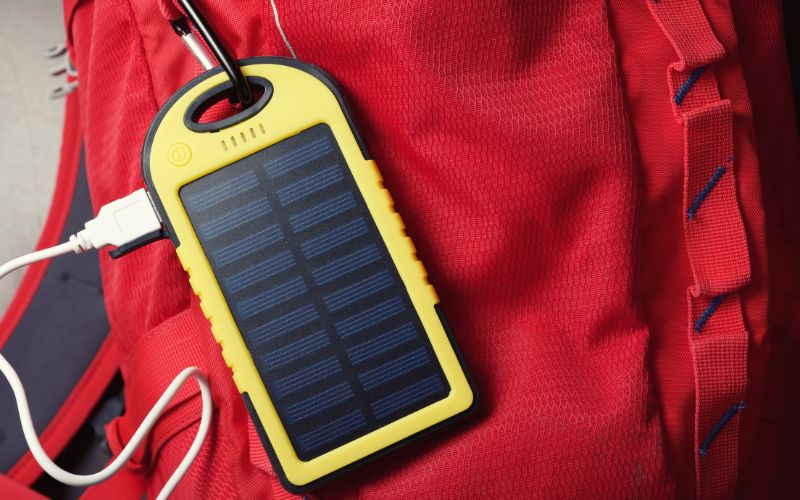
Why Buy A Solar Charger For Backpacking?
Without electrical sockets in the wild to charge your devices, having a solar-powered charger is a great investment for backpackers. A portable backpack solar panel and charger can power GPS devices, e-readers, tablets, some headlamps, and other small devices that can be charged by USB.
Not to mention your cell phone which can have multiple uses on your backpacking trip: communication, GPS, flashlight, weather forecaster, and SOS-sender in emergencies.
A portable charger is an investment that will make sure that if your phone goes dead on you on a multi-day backpacking trip, as long as you have the sun, you’ll have enough power to charge it back up. Ideally, you should have your phone fully charged before setting off and use your charger as a backup.
Another option is to combine the charger with a portable power bank for additional power. We believe a sun-powered charging device shouldn’t be viewed as an afterthought but a piece of essential emergency backup kit for your backpack.
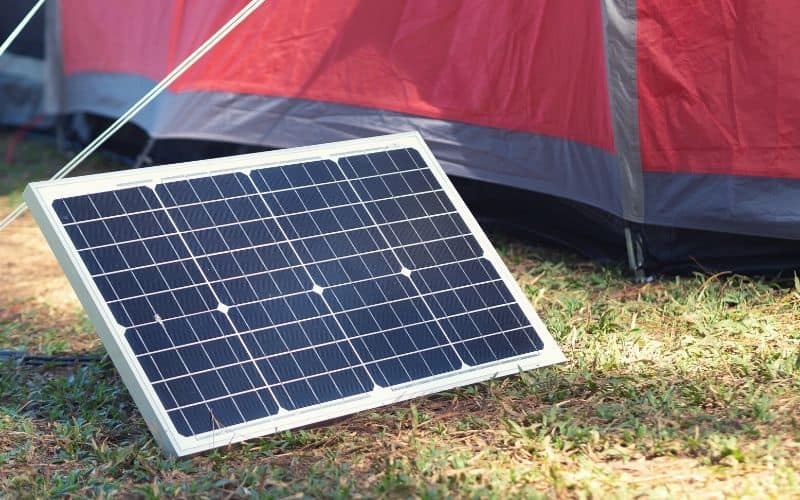
What To Consider When Buying Solar Chargers For Backpacking?
There are a few features to consider when choosing the best solar charging power bank for your needs. The list below outlines what to look for.
- Weight & Size
- Wattage
- USB Ports
- Integrated Battery
Weight & Size
More power usually requires a larger solar panel surface area, adding to size and weight. For backpackers, every ounce counts. The chargers we reviewed are designed for portability and all are compact enough to fit easily into a small backpack whilst bein gof minimal weight. However, they still vary in weight depending on their functionality.
If you only bring one or two devices on your trip, then you likely won’t need a lot of power or additional battery packs. However, if you plan on bringing multiple electronic gadgets that will need charging, you’ll need a more powerful charger and probably a separate battery pack. This, of course, will add to the overall weight.
If you carry a lot of gadgets, a foldable solar panel like the BigBlue 3 or Anker PowerPort Lite is a good option. These devices will let you charge everything you need on a daily basis (the larger surface area lets them charge quicker) and take up surprisingly little space.
The BEARTWO, which weighs a tiny 7.4 oz and can just about fit in your pants pocket, can also charge several (4) devices at once. However, it takes a long time to charge on sunlight alone and won’t power up your devices nearly as quickly.
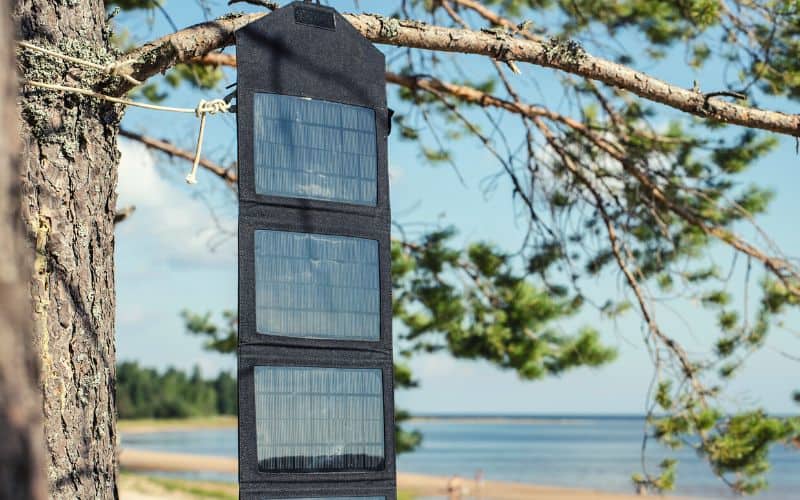
Wattage
As mentioned, the size of the solar panels correlates to the wattage. As a general rule, 5W is enough to power a smartphone, small USB device, or headlamp battery. The higher the wattage, the faster and more effective the charging will be.
USB Ports
If you need to charge multiple devices simultaneously then the number of USB ports the device has becomes important. The chargers we reviewed have one to three USB ports, except for the Riapow Power Bank, which can charge up to four devices at once with its wireless charging capability.
One port should suffice unless you plan to charge multiple devices at the same time. But keep in mind it will take longer for them to become fully charged when you charge many devices at once.
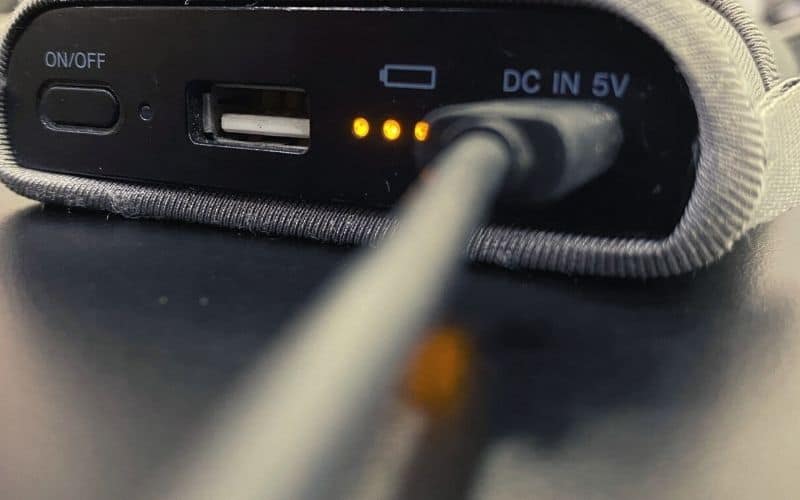
Integrated Battery
If you want stored power to charge your devices later, you’ll need a charger with an integrated battery pack or a separate power bank with at least 10,000 mAh of juice. An integrated or internal battery bank will add weight to the charger but, importantly, provide the ability to store power.
Devices with a built-in battery on our list are the BEARTWO, OEUUDD, Riapow Power Bank, and the BioLite SolarPanel 5+.
Best Solar Charger for Backpacking: The Verdict
For the most powerful and reliable solar power source for backcountry travel, our top pick is the BigBlue 3. This solar panel charger is a beast. It charges quickly, can power up multiple devices at once, and continues producing energy even when it’s cloudy.
If you’re looking for a low-cost alternative, we recommend the BEARTWO and OEUUDD solar power banks. These devices take a little longer to charge multiple devices but are compact, robust, and will keep your phone powered up for the duration of any trip in clear weather.
So, how did you find our solar charger reviews? If we missed anything or you have any questions, let us know! And if you’d like to share this post with your friends, please do!
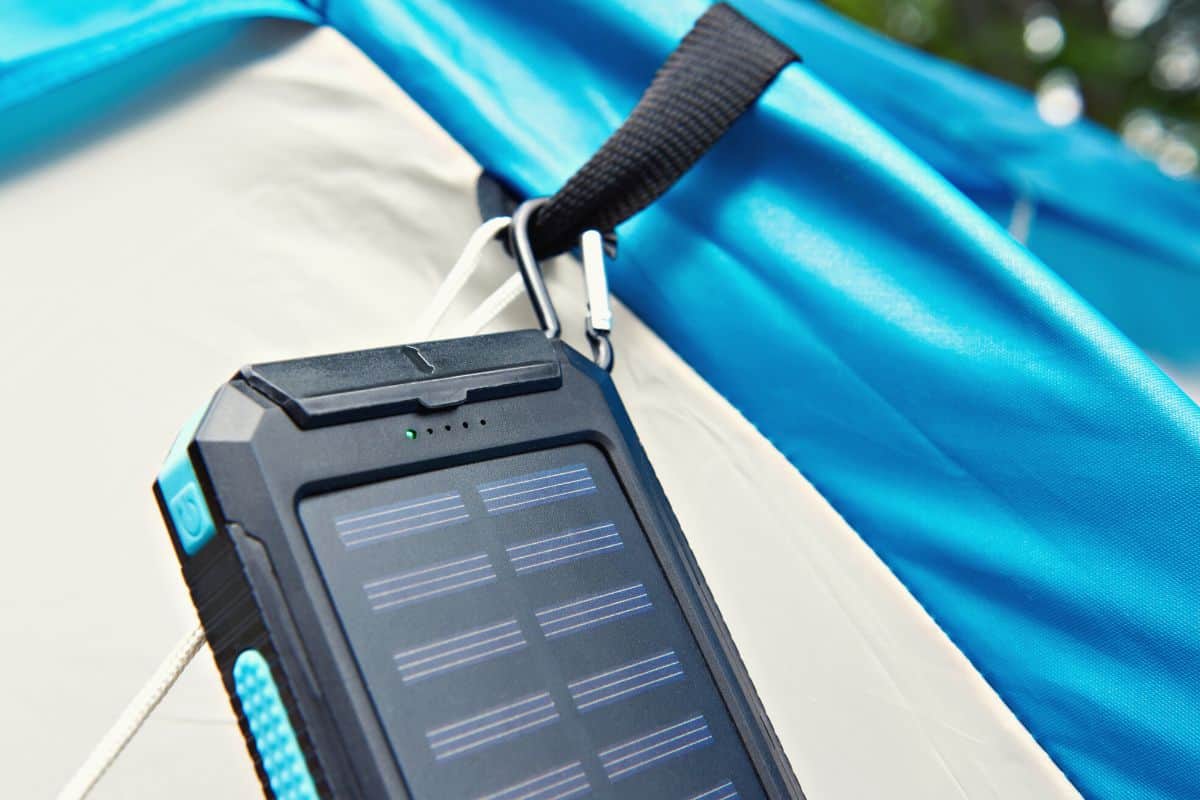

![[Upgraded] BigBlue 3 USB Ports 28W Solar Charger(5V/4.8A Max), Portable SunPower Solar Panel for Camping, IPX4 Waterproof, Compatible with iPhone 11/XS/XS Max/XR/X/8/7, iPad, Samsung Galaxy LG etc.](https://m.media-amazon.com/images/I/41gVrkEOUHL.jpg)
![[Upgraded] BigBlue 3 USB Ports 28W Solar Charger(5V/4.8A Max), Portable SunPower Solar Panel for Camping, IPX4 Waterproof, Compatible with iPhone 11/XS/XS Max/XR/X/8/7, iPad, Samsung Galaxy LG etc.](https://m.media-amazon.com/images/I/51uKshY4skL.jpg)
![[Upgraded] BigBlue 3 USB Ports 28W Solar Charger(5V/4.8A Max), Portable SunPower Solar Panel for Camping, IPX4 Waterproof, Compatible with iPhone 11/XS/XS Max/XR/X/8/7, iPad, Samsung Galaxy LG etc.](https://m.media-amazon.com/images/I/51KFOw6ufOL.jpg)
![[Upgraded] BigBlue 3 USB Ports 28W Solar Charger(5V/4.8A Max), Portable SunPower Solar Panel for Camping, IPX4 Waterproof, Compatible with iPhone 11/XS/XS Max/XR/X/8/7, iPad, Samsung Galaxy LG etc.](https://m.media-amazon.com/images/I/51BA3b8HOTL.jpg)
![[Upgraded] BigBlue 3 USB Ports 28W Solar Charger(5V/4.8A Max), Portable SunPower Solar Panel for Camping, IPX4 Waterproof, Compatible with iPhone 11/XS/XS Max/XR/X/8/7, iPad, Samsung Galaxy LG etc.](https://m.media-amazon.com/images/I/51VMA-mMKHL.jpg)
![[Upgraded] BigBlue 3 USB Ports 28W Solar Charger(5V/4.8A Max), Portable SunPower Solar Panel for Camping, IPX4 Waterproof, Compatible with iPhone 11/XS/XS Max/XR/X/8/7, iPad, Samsung Galaxy LG etc.](https://m.media-amazon.com/images/I/41gVrkEOUHL._SL160_.jpg)
![[Upgraded] BigBlue 3 USB Ports 28W Solar Charger(5V/4.8A Max), Portable SunPower Solar Panel for Camping, IPX4 Waterproof, Compatible with iPhone 11/XS/XS Max/XR/X/8/7, iPad, Samsung Galaxy LG etc.](https://m.media-amazon.com/images/I/51uKshY4skL._SL160_.jpg)
![[Upgraded] BigBlue 3 USB Ports 28W Solar Charger(5V/4.8A Max), Portable SunPower Solar Panel for Camping, IPX4 Waterproof, Compatible with iPhone 11/XS/XS Max/XR/X/8/7, iPad, Samsung Galaxy LG etc.](https://m.media-amazon.com/images/I/51KFOw6ufOL._SL160_.jpg)
![[Upgraded] BigBlue 3 USB Ports 28W Solar Charger(5V/4.8A Max), Portable SunPower Solar Panel for Camping, IPX4 Waterproof, Compatible with iPhone 11/XS/XS Max/XR/X/8/7, iPad, Samsung Galaxy LG etc.](https://m.media-amazon.com/images/I/51BA3b8HOTL._SL160_.jpg)
![[Upgraded] BigBlue 3 USB Ports 28W Solar Charger(5V/4.8A Max), Portable SunPower Solar Panel for Camping, IPX4 Waterproof, Compatible with iPhone 11/XS/XS Max/XR/X/8/7, iPad, Samsung Galaxy LG etc.](https://m.media-amazon.com/images/I/51VMA-mMKHL._SL160_.jpg)













